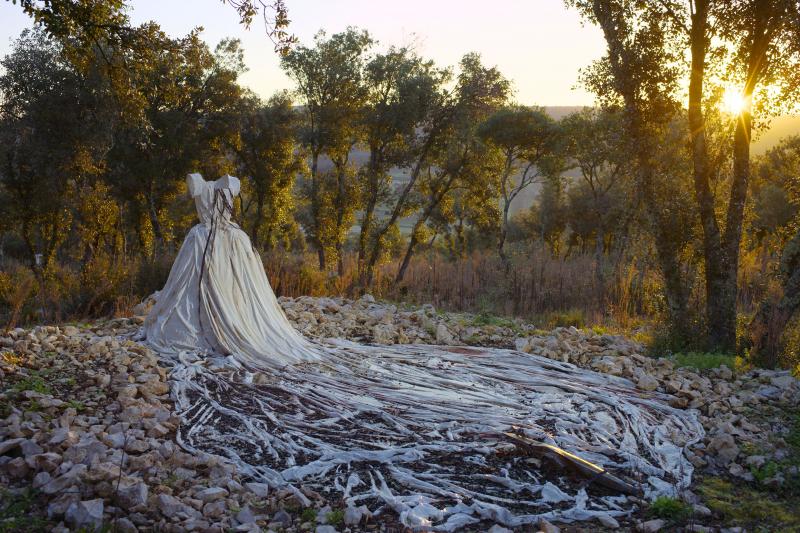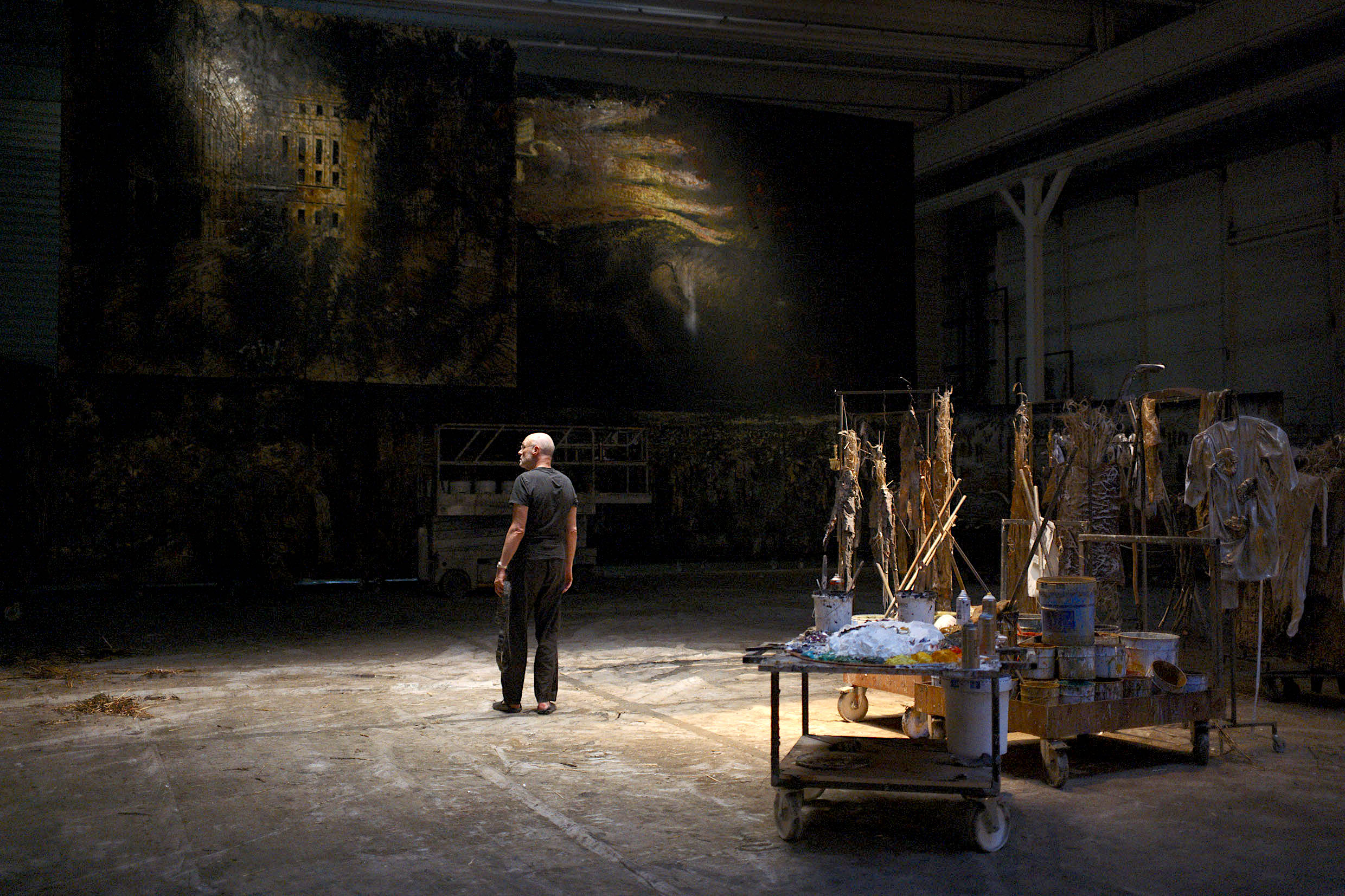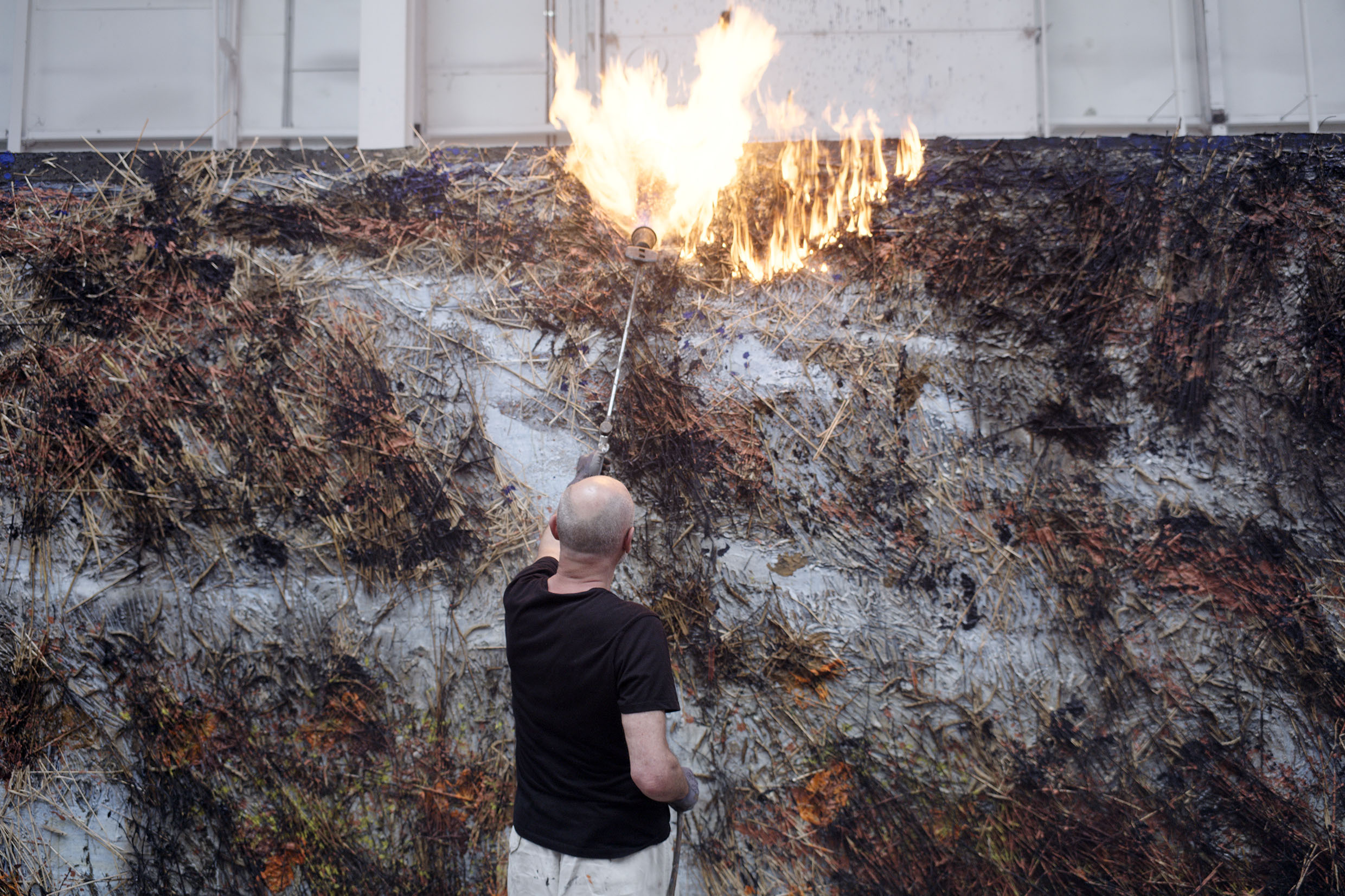Anselm review - post-war German reckonings in 3D | reviews, news & interviews
Anselm review - post-war German reckonings in 3D
Anselm review - post-war German reckonings in 3D
Wim Wenders' uniquely insightful immersion in Anselm Kiefer's monumental, mystic art

Water glassily reflects in a bridal train, the sun moves between trees, giving way to metal book-leaves, and inside a warehouse so vast he cycles through it, stored cliffs of Anselm Kiefer’s work loom over him. Wim Wenders’ 3D cameras bring you inside the artist’s monumental, mythic world, which he is uniquely equipped to comprehend.
The two men met and talked for weeks in 1991, losing regular touch when Kiefer moved to the French studio in rural Barjac where Anselm begins. Two further years of conversation and observation went into this film, which portrays its artist by shifting impressionistically through time and space, reaching biography last. Anselm experiences Kiefer before reducing itself to facts.
Like Wenders’ Pina and his peer Werner Herzog’s Cave of Forgotten Dreams, which explored otherwise inaccessible, preserved prehistoric art, 3D is more than a fairground toy here, extending our lived experience. Biopic-style, acted scenes of the younger artist are patchier, lacking Wenders’ control of movement and form as he composes and immerses himself in the work. Wenders and Kiefer were born months apart in a ruined, cursed country in 1945. Wenders’ Road Movie trilogy responded by dreaming an American freedom in West Germany’s autobahns and fields. There is no more restorative place in Seventies cinema than wandering with Rüdiger Vogler and his girl companion through Alice in the Cities’ black-and-white Rhineland vistas. Wenders reacted as profoundly as Kiefer to amnesia at Jewish extermination, but filled the silence with rock’n’roll and wry humour, to give himself and his generation life. Kiefer ploughed the bones into his work. “You can’t just paint a landscape,” he believes, “when tanks have driven through it.”
Wenders and Kiefer were born months apart in a ruined, cursed country in 1945. Wenders’ Road Movie trilogy responded by dreaming an American freedom in West Germany’s autobahns and fields. There is no more restorative place in Seventies cinema than wandering with Rüdiger Vogler and his girl companion through Alice in the Cities’ black-and-white Rhineland vistas. Wenders reacted as profoundly as Kiefer to amnesia at Jewish extermination, but filled the silence with rock’n’roll and wry humour, to give himself and his generation life. Kiefer ploughed the bones into his work. “You can’t just paint a landscape,” he believes, “when tanks have driven through it.”
This confronting attitude made him an ‘80s American superstar and suspect figure for Germans, rich enough to extend the art-making fiefdoms which climaxed at Barjac. Old interviews show Kiefer the deadpan provocateur, talking of having “occupied” France in ’68 and work lasting for “2000 years”, “typically” German like the Nazi flag colours on Kraftwerk’s The Man-Machine. It seems Kiefer couldn’t be German without mentioning the war his school-lessons hastened through. His paintings are “chaos with borders”, meant to “bring all this back into the world and express it”. Wenders watches his fellow septuagenarian torch smouldering metal panels. Work of overwhelming material scale is made in great Speer-like hangars or from petrified fighter planes, including the raw viscera, blistered bark and vomited metal which Nazi architecture crushed flat. This is art as a battlefield, dark and heavy. Pursued by Wenders to his 2022 Venice Biennial exhibition in the sunlit, golden Doge’s Palace, Kiefer moves purposefully through the unaccustomed brightness, and peers quizzically at a religious piece. Yet travels to India and the East affirmed his cosmic mysticism.
Wenders watches his fellow septuagenarian torch smouldering metal panels. Work of overwhelming material scale is made in great Speer-like hangars or from petrified fighter planes, including the raw viscera, blistered bark and vomited metal which Nazi architecture crushed flat. This is art as a battlefield, dark and heavy. Pursued by Wenders to his 2022 Venice Biennial exhibition in the sunlit, golden Doge’s Palace, Kiefer moves purposefully through the unaccustomed brightness, and peers quizzically at a religious piece. Yet travels to India and the East affirmed his cosmic mysticism.
Wenders is a German romantic, in a tradition perverted and pummelled by Hitler, and Kiefer too disappeared for years into one of the deep forests central to the national imagination, where folk-tales saw young men seek fortunes and be transformed, and wolves wait in the dark. Wenders also conjures a whispering babel of voices in Barjac’s otherwise silent fields, winding revenant “forgotten ones” around the work, alongside Kiefer’s formative fascination with artists such as his mentor Joseph Beuys and the Jewish poet Paul Celan, subject to Soviet, Nazi and Romanian wartime persecution. Celan’s words – “Death is a master from Germany/His eyes are blue” – are among the soft incantations filling in Kiefer’s intellectual and moral hinterland.
Anselm conversely reveals as much about Wenders as his subject – these sons of a dead world who tirelessly worked to climb out of it and light the dark.
rating
Explore topics
Share this article
The future of Arts Journalism
You can stop theartsdesk.com closing!
We urgently need financing to survive. Our fundraising drive has thus far raised £49,000 but we need to reach £100,000 or we will be forced to close. Please contribute here: https://gofund.me/c3f6033d
And if you can forward this information to anyone who might assist, we’d be grateful.

Subscribe to theartsdesk.com
Thank you for continuing to read our work on theartsdesk.com. For unlimited access to every article in its entirety, including our archive of more than 15,000 pieces, we're asking for £5 per month or £40 per year. We feel it's a very good deal, and hope you do too.
To take a subscription now simply click here.
And if you're looking for that extra gift for a friend or family member, why not treat them to a theartsdesk.com gift subscription?
more Film
 London Film Festival 2025 - crime, punishment, pop stars and shrinks
Daniel Craig investigates, Jodie Foster speaks French and Colin Farrell has a gambling habit
London Film Festival 2025 - crime, punishment, pop stars and shrinks
Daniel Craig investigates, Jodie Foster speaks French and Colin Farrell has a gambling habit
 I Swear review - taking stock of Tourette's
A sharp and moving tale of cuss-words and tics
I Swear review - taking stock of Tourette's
A sharp and moving tale of cuss-words and tics
 A House of Dynamite review - the final countdown
Kathryn Bigelow's cautionary tale sets the nuclear clock ticking again
A House of Dynamite review - the final countdown
Kathryn Bigelow's cautionary tale sets the nuclear clock ticking again
 theartsdesk Q&A: Idris Elba on playing a US President faced with a missile crisis in 'A House of Dynamite'
The star talks about Presidential decision-making when millions of lives are imperilled
theartsdesk Q&A: Idris Elba on playing a US President faced with a missile crisis in 'A House of Dynamite'
The star talks about Presidential decision-making when millions of lives are imperilled
 Urchin review - superb homeless drama
Frank Dillane gives a star-making turn in Harris Dickinson’s impressive directorial debut
Urchin review - superb homeless drama
Frank Dillane gives a star-making turn in Harris Dickinson’s impressive directorial debut
 Mr Blake at Your Service review - John Malkovich in unlikely role as an English butler
Weird comedy directed by novelist Gilles Legardinier
Mr Blake at Your Service review - John Malkovich in unlikely role as an English butler
Weird comedy directed by novelist Gilles Legardinier
 Don't Let's Go to the Dogs Tonight review - vivid adaptation of a memoir about a Rhodesian childhood
Embeth Davidtz delivers an impressive directing debut and an exceptional child star
Don't Let's Go to the Dogs Tonight review - vivid adaptation of a memoir about a Rhodesian childhood
Embeth Davidtz delivers an impressive directing debut and an exceptional child star
 One Battle After Another review - Paul Thomas Anderson satirises America's culture wars
Leonardo DiCaprio, Teyana Taylor, and Sean Penn star in a rollercoasting political thriller
One Battle After Another review - Paul Thomas Anderson satirises America's culture wars
Leonardo DiCaprio, Teyana Taylor, and Sean Penn star in a rollercoasting political thriller
 Steve review - educator in crisis
Cillian Murphy excels as a troubled headmaster working with delinquent boys
Steve review - educator in crisis
Cillian Murphy excels as a troubled headmaster working with delinquent boys
 Can I get a Witness? review - time to die before you get old
Ann Marie Fleming directs Sandra Oh in dystopian fantasy that fails to ignite
Can I get a Witness? review - time to die before you get old
Ann Marie Fleming directs Sandra Oh in dystopian fantasy that fails to ignite
 Happyend review - the kids are never alright
In this futuristic blackboard jungle everything is a bit too manicured
Happyend review - the kids are never alright
In this futuristic blackboard jungle everything is a bit too manicured

Add comment